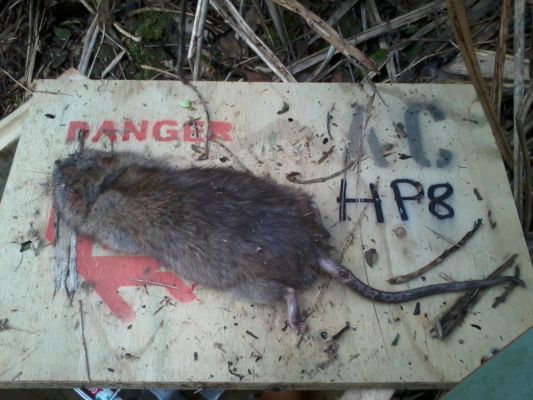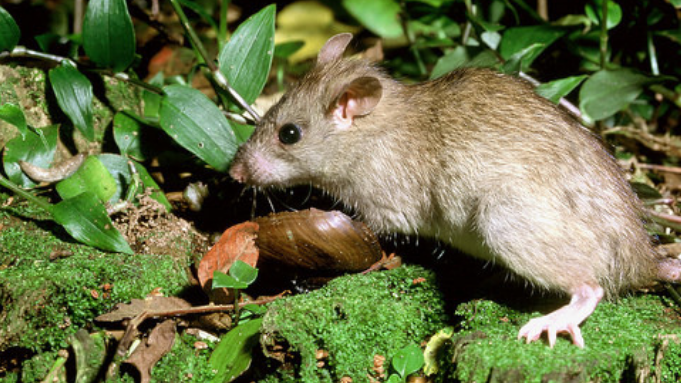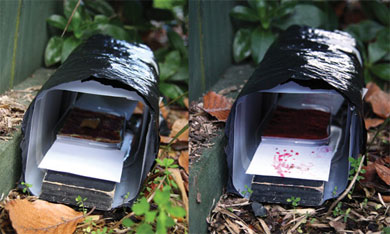Peanut butter is the standard rat attractant – and apparently, they’re pretty keen on chocolate and Nutella too. But researchers at Victoria University of Wellington’s ‘Centre for Biodiversity and Restoration Ecology’ have come up with some chemical compounds that wild rats seem to rate even better than peanut butter. The quest for an irresistible rat lure continues.

“Olfaction is the oldest and frequently the most important sense for animals. Through sensing, processing, translating and interpreting thousands of different chemical signals in their environment, animals can regulate social and physiological behaviours, like mate-finding and reproduction, and locating food. For most mammals, and especially rodents, olfaction is their primary sense, but despite its importance it remains one of the least understood senses.”
The environment is full of complex mixes or aromas and chemical compounds but getting a response may not need to be that complicated. A single key chemical may be enough to trigger a response – and a single key chemical is much easier to recreate in an artificial lure.
“There is mounting evidence that single compounds can act as signals and cues for mammals and that when presented at their optimal concentration they can elicit behavioural responses that replicate those recorded for complex mixtures like gland secretions and foods.”
Seeing what lab rats respond to is one thing – but to really know what works in the real world, checking out the responses of wild rats is likely to be a more realistic test.
“Single compound semiochemicals and cues have been reported to elicit an array of behavioural responses in mammals like biting and chewing responses in canids and felids, attraction, aversion and inter-male agression in mice and aversion, anxiety, mother-young development primers and female attraction in rats. However, studies investigating olfactory-mediated behavioural responses to semiochemicals and cues are almost exclusively performed using laboratory-bred animals (e.g., Wistar rats or house mice) or captive animals held in pens, not free-ranging wild animals.”
This study, carried out by Michael D. Jackson, Robert A. Keyzers and Wayne L. Linklater, tested the responses of wild, free-ranging rats to 9 substances previously identified in foods.
“We designed a rapid bioassay to present nine compounds that we had previously identified in foods, each at seven different concentrations (63 treatments), to wild, free-ranging rats and scored each treatment for attraction and three behavioural responses. Nine treatments (taken from five compounds) statistically outperformed the current standard rat attractant, peanut butter.”
Interestingly, the rats were more attracted to the chemicals when they were present in lower concentrations. Perhaps higher concentrations are too much of a good thing and overwhelm the rat’s sensory system.

“Attraction to treatments was highest at the two lowest concentrations (0.1 and 0.01 μg g−1) and a statistically significant relationship of increasing attraction with decreasing treatment concentration was identified.”
Several potential alternatives to peanut butter were identified.
“Our study identified five compounds not previously associated with behavioural responses by rats that elicit equivalent or more intense behavioural responses than those obtained with peanut butter. Moreover, attraction to treatments was driven by a concentration-dependent relationship not previously reported. This is the first study to identify isopentanol, 1-hexanol, acetoin, isobutyl acetate and 2-methylbutyl acetate as possible semiochemicals/cues for rats. More broadly, our findings provide important guidance to researchers in the ongoing search for mammalian semiochemicals and cues.”
There’s still a lot more to discover about how these chemicals and others yet to be discovered, can be used most effectively. A number of different factors can impact results and needed to be controlled in this experiment’s methodology.
“The search for semiochemicals and cues, whether single compounds or blends, is made difficult by a range of species- and compound-specific and environmental factors that have the capacity to significantly impact their identification. Firstly, an animal’s behavioural response to a compound is commonly concentration-dependent. For example, rats are attracted to carbon disulphide, dimethyl disulphide and dimethyl sulphide at 50 μg per gram but repelled at 100 μg per gram. Secondly, an animal’s detection threshold to compounds is also compound-dependent. Rats have a detection threshold of 0.0001 ng per gram for 2,4,5-trimethylthiazoline, a predator odour that elicits fear in rats, but a threshold of just 1 μg per gram for some aliphatic esters; a difference of seven orders of magnitude.”
A high sensitivity to a compound may indicate how important that compound is to the animal’s behaviour. If it’s important, that may make it more promising as a potential lure. But then there are environmental factors (such as wind) and how they interact with the properties of the compound itself (such as how easily it vaporises) that could also impact on a chemical’s effectiveness as a lure in real-world conditions and could have potentially confused interpretation of results in this study.
“A compound’s molecular weight, vapour pressure and a suite of environmental factors directly impact signal propagation. Advection and turbulence can lead to patchy odour-active spaces (the space in which the compound is at, or above, the animals detection threshold), while wind can dramatically decrease the concentration of the compound at or near its source. Lastly, in-field studies are often subject to a range of logistical constraints. For example, monitoring devices like camera-traps are expensive to buy while their bulk, weight and installation time means relatively low numbers of treatments can be assayed at the same time. Further, scoring videos for behaviours is time consuming, therefore costly. Thus, studies aiming to identify signals or cues using wild, free-ranging animals must cope with extraordinary chemical, environmental and animal variance, and ensure that large numbers of treatments are subjected to within and between site replication in a balanced assay design.”
So how did the researchers design an experiment to cope with all this potential variance in their research conditions? Good old tracking tunnels helped.

“We devised a rapid, highly replicable, field-based assay using tracking tunnels that are used internationally to monitor rats and have previously been used assess the attractiveness of compounds on wild rats. This allowed us to overcome the enormous environmental, species- and compound-specific issues associated with presenting compounds to wild, free-ranging animals and ensured we could assay the large number of treatments we intended to present in a robust, balanced design.”
Why might these particular chemicals have been attractive to rats?
“Intriguingly, three of the five top performing compounds (isopentanol, 1-hexanol and acetoin) have been reported in rat urine, although they have not been formally characterised as pheromones.”
The fact that rats preferred these chemicals at lower concentrations is apparently not unlike human responses to aromas found in wine.
“Low attraction rates to higher concentrations may be due to the animal’s olfactory receptors interpreting the compounds differently or becoming fatigued through their saturation and ultimately leading to avoidance and/or repellence. Thus, the perceived aroma of the compounds may have changed with increasing concentration. A human example is 4-methyl-4-sulfanylpentan-2-one that typically occurs in wines made with Sauvignon blanc grapes. Below 5 ng per litre humans discern this compound as having an aroma of passionfruit, but it smells of cat urine at around 5 ng per litre or above.”
As the rats in this study preferred the lowest concentration of compounds tested, they may have an even stronger response to concentrations that are lower still.
“It is possible we may not have identified peak attraction in rats, as our study did not present the compounds at concentrations lower than 0.01 μg per gram (the concentration with the highest attraction rate). We suggest future studies should present the same compounds at concentrations lower than those used in this study as this will allow for the elucidation of the rat’s peak concentration response and may, therefore, help pin-point the optimal concentrations for attraction and the behavioural responses for each of these compounds.”
This research has been published in Nature’s, Scientific Reports and is freely available online.
Single compounds elicit complex behavioural responses in wild, free-ranging rats (2018)

